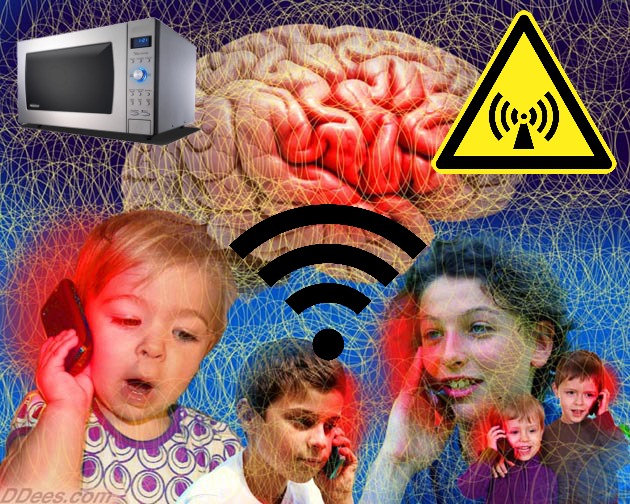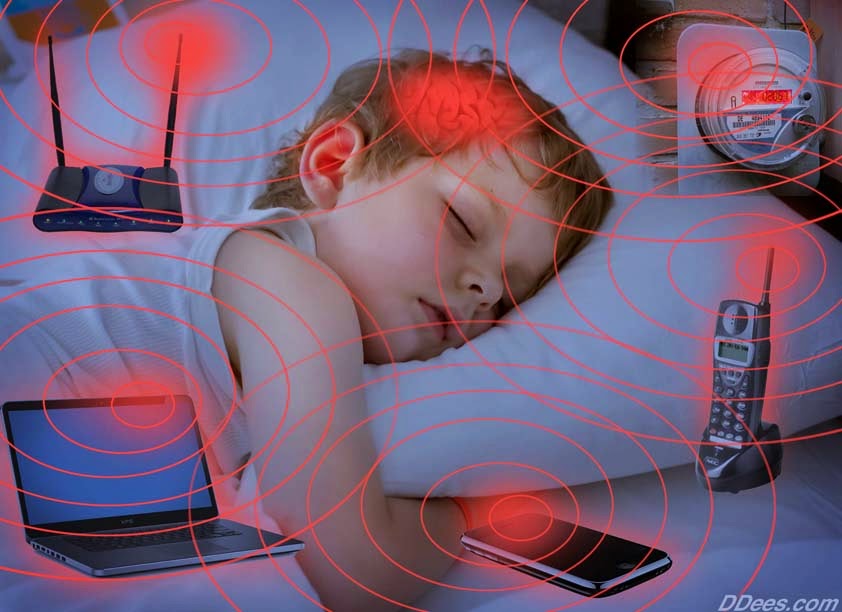Children’s Exposure Guidelines to EMF Radiofrequencies Updated by ANSES
In France, there’s a governmental agency called ANSES that deals with health issues, e.g., food, environmental and occupational health safety, established July 1, 2010, incorporating and/or taking over two previous government agencies: the French Food Safety Agency (AFSSA) and the French Agency for Environmental and Occupational Health Safety (AFSSET). ANSES is the acronym for Administración Nacional de la Seguridad Social in the French language.
ANSES is an international player, which participates in European and international organizations projects plus the development of scientific cooperation with key partners abroad. [1]
Besides its assessment of risks to human health from food and animal consumption, ANSES also is tasked with assessing medicinal products for human and veterinary use coordinated by the European Medicines Agency, which published a questionable assessment report in November 2015 [2] regarding the adverse health events surrounding the HPV vaccines, which The Nordic Cochrane Centre challenged.
ANSES “is the national focal point for the European Food Safety Authority (EFSA).” [3]
Widget not in any sidebars
Rather recently (July 2016), ANSES issued the report “Exposure of children to radiofrequencies: a call for moderate and supervised use of wireless technologies,”… , which seems to be an update attempt on previous similar reports issued in 2013 and 2009 referenced here.
Graphic Source [Dees Illustration]
In reading the 2016 update, there doesn’t seem to be much of anything new added, in my opinion, and seemingly ANSES steers away from the WHO’s IARC’s classification of EMFs as a class 2B carcinogen.
In the 2013 update, ANSES wrote:
All the potential health effects of radiofrequencies, carcinogenic or not, were studied and their levels of evidence classified on the basis of an assessment method inspired by that of the WHO’s International Agency for Research on Cancer (IARC).
The findings of the risk assessment have not brought to light any proven health effects. Certain publications nonetheless mention a possible increase in the risk of cerebral tumours, in the long term, for heavy mobile phone users. The findings of this expert appraisal are therefore consistent with the classification of radiofrequencies proposed by the World Health Organization’s International Agency for Research on Cancer (IARC) as “possibly carcinogenic” for heavy users of mobile phones. In addition, the expert appraisal nevertheless shows, with limited levels of evidence, different biological effects in humans or animals, some of which had already been reported in 2009: these can affect sleep, male fertility or cognitive performance.
[….]
The Agency also highlights the massive growth in applications of radiofrequencies in indoor or outdoor environments, leading to an increase in population exposure.
Therefore, to limit exposure to radiofrequencies, especially in the most vulnerable population groups, the Agency recommends:
for intensive adult mobile phone users (in talk mode): use of hands-free kits and more generally, for all users, favouring the purchase of phones with the lowest SAR[1] values;
reducing the exposure of children by encouraging only moderate use of mobile phones; continuing to improve characterisation of population exposure in outdoor and indoor environments through the use of measurement campaigns;
that the development of new mobile phone network infrastructures be subject to prior studies concerning the characterisation of exposures, and an in-depth study be conducted of the consequences of possibly multiplying the number of relay antennas in order to reduce levels of environmental exposure;
documenting the conditions pertaining at those existing installations causing the highest exposure of the public and investigating in what measure these exposures can be reduced by technical means.
that all common devices emitting electromagnetic fields intended for use near the body (DECT telephones, tablet computers, baby monitors, etc.) display the maximum level of exposure generated (SAR, for example), as is already the case for mobile phones.
Finally, in order to resolve the various uncertainties it identified when conducting this work, and in addition to the research projects already undertaken under the National Plan for Research on Environmental and Occupational Health, the Agency is also making a series of research recommendations. [4] [CJF emphasis]
The question this writer feels compelled to ask is why there doesn’t seem to be a specified plan to address scientifically the issues of cancer-causing potentialities regarding EMFs emitted from wireless communication devices and SARs, which impact not only children but everyone, including animals and vegetation.
Instead, the 2016 ANSES update suggests “Possible effects on cognitive functions and well-being” and the fact that “Children exposed ever earlier to radiofrequency electromagnetic fields” and “The Agency’s recommendations” that state:
On the basis of the results of the expert appraisal, the Agency is recommending that the regulations be changed in order that:
- all radio devices, and in particular those intended for children (tablet computers, baby monitors, connected toys, etc.), are subject to the same regulatory obligations, in terms of control of exposure levels and information to the public, as those governing mobile telephones;
- the regulatory exposure limit values are enforced, regardless of the mobile transmitter devices used, according to reasonably foreseeable conditions of use (for example positioning in contact with the body).
It also seems necessary to
reconsider the reference levels aiming to limit environmental exposure to electromagnetic radiofrequency fields, in order to ensure that the safety margins are large enough to protect the health and safety of the general population, and particularly of children;
reassess the relevance of the specific absorption rate (SAR) used to establish exposure limit _ values for individuals, for the purposes of protection against the known and proven health _ effects (thermal effects) of radiofrequencies, and develop a representative indicator of the actual exposure of mobile telephone users, regardless of the conditions of use: signal used, good or bad reception, method of use (voice calls, loading data, etc.). [4] [CJF emphasis]
Seems necessary? What a puny remark, which vested interests will not take seriously nor implement measures to generate specific SARs. Because, if they did, the results would put them out of business, I proffer. The excessive EMFs coming off many smart appliances, especially the newly rolled out AMI Smart Meters, which are the linchpin of global surveillance, will enable the Internet of Things not only to control our lives, but become BIG BROTHER literally!
Natural and Non-Toxic Products. Up to 50% Off – Every Day (Ad)
Regarding SAR (specific absorption rate), I think it is absolutely imperative that every public utility commission in every one of the 50 states and territories of the USA establish immediately, if not sooner, uniform SARs and mandate that the technology industries meet those criteria for retrofitting current gadgets, plus re-engineering new ones in production or on drawing boards.
Furthermore, the sixty-year-old “known and proven” thermal effects from early radar studies are very outdated. However, they are effective since that’s what public utility companies and PUCs trot out as microwaves being ‘safe’. Those sixty-year-old studies do not include non-thermal adverse health effects, which are the ‘new kids on the block’ in current EMF research no one in the microwave industries wants to recognize because if they did, they probably would be doing business a heck of a lot differently, or with much less gusto regarding implementing AMI Smart Meters.
However, if states public utility commissions don’t recognize RF/EMF non-thermal adverse effects soon and make necessary changes within their utility regulations, I can foresee massive lawsuits being filed against utility companies, AMI Smart Meter manufacturers, and state public utility commissions—including commission members—charging failure to protect public health and the deliberate neglect of fiduciary responsibilities in view of established non-thermal radiation science and academic literature.
Consumers really don’t understand the unforeseen dynamics of EMFs coming off all the ‘smart’ technology we have become so enthralled with. However, children may be paying the highest price of all because of their attraction to and fascination with such gadgets.
There are serious repercussions the ANSES 2016 report skirted around in the second to last paragraph of its report:
the expert appraisal identified several studies highlighting an association between intensive and inadequate use of mobile telephones by young people and mental
health problems (risk behaviour, depression, suicidal thoughts, etc.). [4] [CJF emphasis]
Cell phone exposures are one thing; they can be turned off! However, AMI Smart Meters cannot be turned off; they send dirty electricity thousand-fold over 60 Hz house wiring that radiates EMFs into the home environment effectively creating an ‘operating microwave oven-like’ atmosphere 24/7/365.
Now can you understand why tech companies don’t want to pursue SAR research and why states public utility commissions ought to be pushing the panic button about lawsuits for industry and themselves?
Image: Dees Illustration, modified by Editor
References:
[1] https://www.anses.fr/en/content/anses-representing-france-international-organisations
[3] https://www.anses.fr/en/content/anses-representing-france-international-organisations
[4] https://www.anses.fr/en/content/anses-issues-recommendations-limiting-exposure-radiofrequencies
Catherine J Frompovich (website) is a retired natural nutritionist who earned advanced degrees in Nutrition and Holistic Health Sciences, Certification in Orthomolecular Theory and Practice plus Paralegal Studies. Her work has been published in national and airline magazines since the early 1980s. Catherine authored numerous books on health issues along with co-authoring papers and monographs with physicians, nurses, and holistic healthcare professionals. She has been a consumer healthcare researcher 35 years and counting.
Catherine’s latest book, published October 4, 2013, is Vaccination Voodoo, What YOU Don’t Know About Vaccines, available on Amazon.com.
Her 2012 book A Cancer Answer, Holistic BREAST Cancer Management, A Guide to Effective & Non-Toxic Treatments, is available on Amazon.com and as a Kindle eBook.
Two of Catherine’s more recent books on Amazon.com are Our Chemical Lives And The Hijacking Of Our DNA, A Probe Into What’s Probably Making Us Sick(2009) and Lord, How Can I Make It Through Grieving My Loss, An Inspirational Guide Through the Grieving Process (2008)
Catherine’s NEW book: Eat To Beat Disease, Foods Medicinal Qualities©2016Catherine J Frompovich is now available





